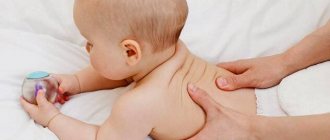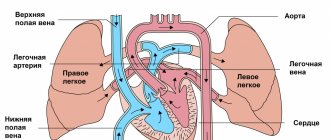Causes of pseudobulbar dysarthria in children
The immediate cause of the defect is damage to the pathways, that is, the nerve fibers connecting the nuclei of the bulbar nerves in the medulla oblongata with the cerebral cortex. The bulbar nerves are the vagus, glossopharyngeal and hypoglossal. The names make it clear which muscles these nerves innervate.
In pathology, the interaction is disrupted. The activity of the nuclei increases, which causes hypertonicity of the articulatory muscles. This makes it difficult for muscles to oscillate when speaking, reduces the ability to make active movements, and interferes with the process of swallowing and chewing food. At the same time, a characteristic of pseudobulbar dysplasia is the preservation of reflex acts that do not require control from the cortex - for example, licking the lips when food enters.
Such violations lead to:
- traumatic brain injuries - concussion, bruise, which are accompanied by damage to the brain matter and the formation of hematomas. They, in turn, cause disruption of blood flow and compression of the pathways. Children can also be injured during childbirth as a result of inadequate management of labor;
- perinatal pathology - intrauterine infections, asphyxia and hypoxia, entanglement of the umbilical cord, birth injuries, complicated pregnancy and childbirth are fraught with damage to the brain substance;
- neuroinfections - encephalitis, syphilitic brain damage, tuberculosis leads to an inflammatory process in the listed structures;
- neurodegenerative diseases - amyotrophic lateral sclerosis, leukodystrophy leads to the gradual death of nerve fibers connecting the cerebral cortex and bulbar nuclei;
- cerebrovascular disorders - strokes (they are rare in children, but they do occur), encephalopathy (perinatal, diabetic), angiopathy.
Test - check if everything is okay with your baby
Two small checks that parents can carry out at home will help you understand that you urgently need to see a specialist.
First test. All movements must be performed in front of a mirror, first do them yourself, then ask your baby to repeat them.
- Smile, and then stretch out your lips in a tube, while leaving your chin motionless and your jaws closed, moving only your lips.
- Show your tongue and hide it.
- Open your mouth slightly, flatten your tongue on your lower lip and hold it for 3-5 seconds.
- Open and close your mouth wide, slap your lips.
- Open and close your mouth, stretch your lips into a tube.
- Open your mouth and touch the corners of your mouth with the tip of your tongue, move it in different directions, as if it were a clock pendulum.
Second test. Clasp your hands and then ask your baby to do it. Open your fingers and play this game: take turns connecting your thumb with the rest, as if your fingers were shaking hands.
If a child correctly understands what is required of him, but he cannot make these movements, he cannot hold his tongue in the desired position, his smile looks crooked, and his fingers do not connect in any way, then this is a serious cause for concern. You should contact a pediatric neurologist and speech therapist as soon as possible.
Degrees and forms of pseudobulbar dysarthria in children
There are 3 degrees of pseudobulbar dysarthria:
- A mild degree is characterized by the absence of gross violations. The movements of the articulatory organs are slowed down. The speech is understandable, but a little blurry and inexpressive. Rare choking is possible;
- With moderate severity, the signs of pseudobulbar dysarthria are more pronounced, and speech is practically incomprehensible to others. There are problems with chewing, swallowing, facial expressions, and drooling;
- A feature of severe pseudobulbar dysarthria is complete anarthria, that is, lack of speech. The mouth is constantly open, the lower jaw “hangs”, salivation is profuse, the tongue is motionless. Chewing and swallowing of food are severely impaired.
According to another classification, speech therapists take into account the spastic form of pseudobulbar dysarthria, paretic and mixed. Spastic is characterized by muscle spasm, paretic - paresis, mixed has signs of two forms.
Symptoms of pseudobulbar dysarthria in children
Muscle spasm leads to difficulty pronouncing consonants, and in severe cases, vowels. Some are completely inaccessible, some are replaced by simpler ones or distorted. The child speaks slowly, inarticulately, fragmentarily, in short sentences, without intonation. The voice is hoarse, hoarse, through the nose. Words are unclear, sounds in words are blurred.
With a mild degree, children are not able to clearly pronounce “zh”, “sh”, “ch”, “ts”, “r”: these are the most difficult sounds to articulate. There is not enough vocal strength for ringing sounds. It is also difficult to make soft sounds due to problems with raising the tongue to the palate. The writing is disrupted: children write “d” instead of “t”, and write the letter “c” instead of “ch”. In general, they correctly understand word structure, grammar and vocabulary.
Symptoms of moderate pseudobulbar dysarthria include problems pronouncing vowels. The baby incomprehensibly says the sounds “a”, “u”, “i”, “s”. One sound mixes with another. The list of problematic consonants is expanding: “ch”, “ts”, “l”, “r”. They are pronounced while exhaling through the nose with a squelch.
Another feature of pseudobulbar dysarthria is difficulty swallowing, forced laughter or crying. The baby cannot control the closure of the mouth, which is why saliva flows out of the corners of the mouth.
Facial expressions also suffer. She is frozen, uncontrollable. Other neurological problems are also typical: decreased intelligence, poor memory, gait disturbance, hemiparesis.
In children under one year of age, signs of pseudobulbar dysarthria include problems with sucking. Difficulty swallowing may occur, causing the child to choke and cough. Parents usually begin to pay attention to delayed speech development at 2–3 years of age. It is difficult for children to speak, so they usually remain silent. The lack of normal communication impoverishes vocabulary and worsens grammar.
Psychological disorders are also typical: children behave separately and try to isolate themselves.
With severe neurological pathology, the symptoms of the underlying disease come to the fore. With cerebral palsy, these are paresis, paralysis, tone disturbances, hyperkinesis, disturbances in psychomotor development, and unsteadiness of gait.
Symptoms of the disease
The symptoms of pseudobulbar dysarthria depend on the severity, of which there are only four:
- 1st degree – there are no pronounced speech defects, which can be identified by a speech therapist.
- 2nd degree – the child’s speech is understandable, but some speech disorders are noticeable.
- 3rd degree – speech is incomprehensible to people around, including loved ones.
- 4th degree – the patient’s speech is not completely understandable.
The general symptoms of this form of dysarthria have some components:
- distorted syllables, sounds;
- hypertonicity of the facial muscles;
- limited mobility of the tongue and lips;
- increased salivation;
- weak quiet voice;
- arrhythmia of breathing.
A diagnosis of “pseudobulbar dysarthria” can only be made by a speech therapist or neurologist based on certain research results.
Diagnosis of pseudobulbar dysarthria in a child
The defect is diagnosed through a thorough neurological and speech therapy examination, assessment of cerebral blood supply by ultrasound, and neuroimaging. Doctors are faced with the task of not only making the correct diagnosis of the type of pseudobulbar dysarthria, but also identifying the cause, that is, the main pathology of the brain and its prevalence.
Carry out:
- Neurological examination - includes an examination by a neurologist, assessment of the motor skills of articulatory and facial muscles. At this stage, restrictions on facial expressions, disturbances in speech, swallowing, voice, and muscle hypertonicity are detected. Pathological symptoms are identified - sucking, proboscis, strengthening of the pharyngeal and palatal reflex. Based on the presence of focal neurological symptoms, a neurologist can determine the location of the pathological process;
- Speech therapy examination - a specialist conducts a survey, collects a detailed anamnesis about the course of pregnancy and childbirth, the nature of early physical and neuropsychic development. Assess the condition of the speech organs, the level of writing and oral speech;
- Instrumental research methods allow us to determine the presence of pathological foci in the brain: degenerative, inflammatory, tumor, as well as post-traumatic formations. MRI, CT are performed;
- Spinal puncture helps to diagnose neuroinfections, identify the pathogen, conduct PCR and ELISA (immunological tests to determine the pathogen);
- A study of cerebral vascular function may be necessary if a blood flow disorder is suspected.
If necessary, the child is examined by other specialists. For example, if a neuroinfection is suspected, an infectious disease specialist, or a tuberculosis infection, a phthisiatrician.
After an accurate diagnosis has been made and the cause of the defect has been identified, we proceed to the next stage - the selection of treatment tactics for pseudobulbar dysarthria.
Causes and symptoms
The disease is provoked by a number of harmful factors:
- viral diseases of the expectant mother;
- pathologies of the placenta at the stage of intrauterine development;
- Rhesus conflict;
- fetal hypoxia;
- very rapid or slow labor with cerebral hemorrhage in the child;
- some birth injuries;
- prematurity;
- infections of the brain and its membranes, such as meningitis;
- Cerebral palsy (up to 85% of cases of dysarthria);
- TBI;
- hydrocephalus;
- severe intoxication;
- encephalitis. Source: L.I. Belyakova, Yu.O. Filatova Diagnosis of speech disorders // Defectology, 2007
Correction and treatment of pseudobulbar dysarthria in children
The therapy is complex and includes work with a speech therapist, neurologist, neurosurgeon, physical therapy doctor, physiotherapist, and massage therapist. Speech therapy correction of pseudobulbar dysarthria in children is carried out with simultaneous treatment of the pathology that led to the speech defect and a rehabilitation program.
Complex treatment includes:
- Elimination of the cause, which is different for each patient. For neuroinfection, antibacterial therapy is carried out, for hematomas, space-occupying formations - surgery to remove the pathological focus, for encephalopathies - restoration of blood flow;
- The speech therapist uses speech therapy massage to eliminate the increased tone of the articulatory muscles. In order to enhance the effect, breathing and articulation exercises and classes to correct the pronunciation of problematic sounds are carried out. After eliminating the defects, the specialist works to ensure that the child begins to speak not only correctly, but also expressively. This is a long process;
- The rehabilitation program is aimed at consolidating the results of the main treatment and preventing relapse of the disease. Includes physical therapy, massage, reflexology. If necessary, children are also observed by a psychologist. Most often, nootropics, vitamins, and neuroprotectors are prescribed during rehabilitation treatment.
The timing of treatment and its duration are determined by a speech therapist depending on the existing disorders in pseudobulbar dysarthria and their severity. Usually several courses are conducted.
Prognosis and prevention
The prognosis is influenced by the causes, form and degree of pseudobulbar dysarthria. With a mild degree, with a timely start of correctional work, and the absence of severe neurological symptoms, it is possible to significantly improve speech. This means that the child will continue to grow and develop almost on par with his peers. He will be able to study in a regular school, but he may need the help of specialists (speech therapist, psychologist) so that the learning process takes place with maximum benefit and comfort.
For moderate and severe forms of the disease, training in a specialized school is indicated, where specialists will constantly work with him.
If you are late in starting the correction of pseudobulbar dysarthria in children, there is a high probability of severe intellectual disorders and delayed speech development. The child will also have neurotic problems, including depression. This leads to underdevelopment of speech in various forms and threatens reading and writing problems.
As we said, pseudobulbar dysarthria in children often accompanies cerebral palsy. In such a situation, the prognosis is serious and depends on the severity of the violations. Adequate pathogenetic therapy can greatly improve speech. The most severe prognosis is for degenerative processes of the central nervous system.
Prevention of pseudobulbar dysarthria in children consists of preventing diseases that result in the development of pseudobulbar dysarthria. An important point is planning pregnancy, eliminating bad habits during pregnancy, the influence of harmful substances, avoiding contact with infectious patients, emotional and physical overload, injuries, and intoxications. It is unacceptable to work in hazardous working conditions or contact with hazardous substances.
You should regularly see an obstetrician-gynecologist and undergo all diagnostic procedures. If problems arise, follow your doctor’s treatment recommendations. Always consult your doctor before taking any medicine.
It is necessary to take a responsible approach to choosing the method of delivery: if there are indications for a caesarean section, do not refuse the operation. This way you will protect yourself and your baby from injury, keep him healthy, and ensure normal development in the future.
Tips for parents
If you notice your baby has difficulty swallowing or eating at an early age, bring these symptoms to the attention of your doctor. You may need to undergo an examination to rule out neurological problems. And if they are confirmed, you will be able to start treatment in a timely manner, thereby avoiding the progression of the pathology.
At an older age, watch how your child speaks. How he pronounces sounds, syllables, words, whether his speech is understandable to others: these moments are very important. Remember that the most important thing is not to miss the disease. And modern correction methods will help to maximally adapt and prepare the patient for school and life in general.











